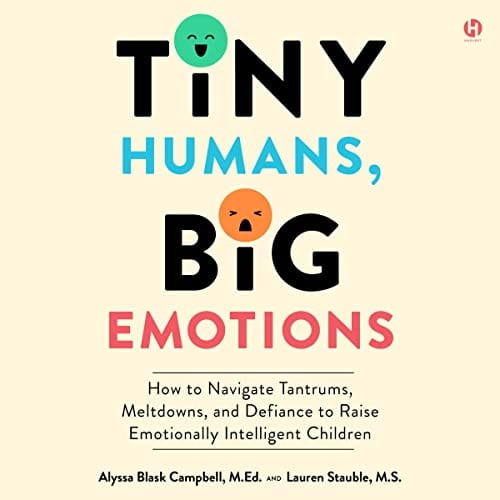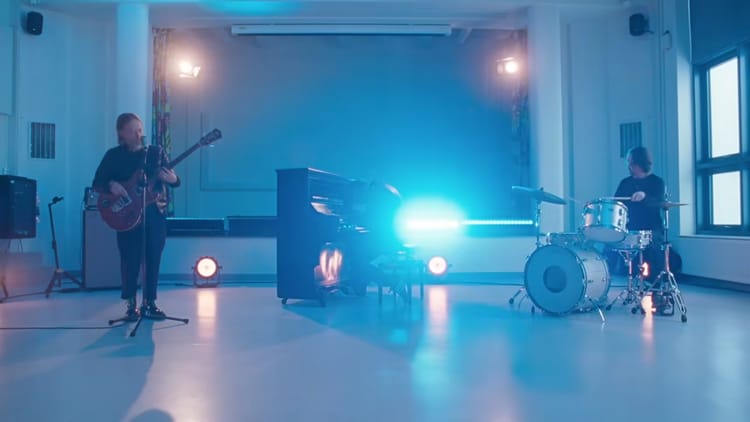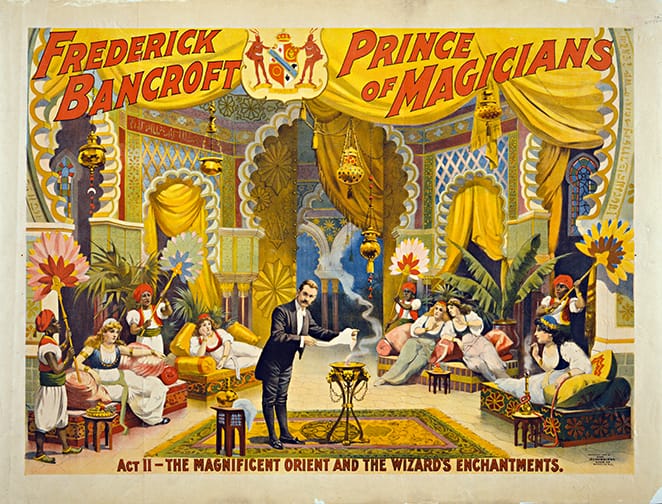The Bluey Files, Part Two: Seed & Sew

This week, I published an essay on my beloved Bluey at Bright Wall/Dark Room. As part of that essay, I talked to parents and Bluey enthusiasts of many stripes, and over here for the remainder of the week, I thought I’d bring you the unedited versions of a couple of those conversations. Today, I’m sharing my conversation with Alyssa Blask Campbell, co-author of the book Tiny Humans, Big Emotions: How to Navigate Tantrums, Meltdowns, and Defiance to Raise Emotionally Intelligent Children. You can read our conversation below, and find Tiny Humans, Big Emotions wherever you get your books.
Note: this conversation has been lightly edited for style and clarity
How did you come to discover Bluey?
Oh my gosh, it's been so in the zeitgeist. I feel like it's one of the few kids shows that adults are like, OK, I can do this. I feel like Bluey came into my space of parents just being like, Oh, what a chill show to be able to put on, like, doesn't drive me bonkers with my kids. So it's really more parent-driven. I think the content of it is good, but I felt like parents were just like, It was like a breath of fresh air. So I feel like it just traveled.
You use the slogan “the future is emotionally intelligent.” Would you elaborate briefly on that philosophy?
I think that what's really rad about raising kids in this time right now is that we have access to research and data that we didn't have access to 30 years ago. And in the same way that, like, the car seat that I put my kid in is different than the car seat that I was in, and the lack of car seat my mom had when she was little–she just held them, my grandma. Now [my kid] is in, like, rear facing fortress ‘til he’s 18, in comparison to what I was in. And when we look at the evolution of social emotional development and learning, we see it in school systems, we're seeing it in awareness of mental health in general. And we're also seeing it in parenting, and in early childhood, and the impacts that we can have on building emotional intelligence from the jump, from infancy. For me, I feel so excited and hopeful about what that means for not just my kid, who I get to raise with these tools, but for the peers he's going to have in school, for the future bosses or employees they'll have, for his partner, for what that means for the way that he's gonna get to show up in life, and the tools that humans around him will hopefully have access to because of our shift, and embracing progress when it comes to social emotional learning.
So if the future is emotionally intelligent, does Bluey demonstrate an emotionally intelligent world?
Totally. I would love to, like, pop in and say, Here's some things that we could do to continue to provide this evolution and progress in depicting this. One of my critiques often of kid shows–just across the board, Bluey being one of them–is, I really want to help folks understand their unique sensory systems, what they're sensitive to, what they're seeking, and how regulation is different for everyone. What are some other ways that you can connect and have playfulness? That sort of thing. That's my one critique. But yes, by and large, like, man, we're moving in a good direction. If I can provide a contrast to another popular kids show, in Daniel Tiger there's a song that's like, If you're mad, turn it around and find something good. Every time I hear it, my insides bubble and I cringe. You don't always have to find a silver lining. It's also okay to just have a hard time and not find something good. And I feel like that has been messaging that's been out there on kid shows—it's like, you're not supposed to be mad, you're not supposed to have a hard time. And Bluey is changing that. I love that it’s not just, like, all feelings are welcome here, but truly seeing that in practice, that yeah, you get to have a hard time and not be shamed or punished for being dysregulated. We all have a hard time sometimes.
Bandit has been criticized as setting an impossible standard for parents, particularly with regard to how much he plays. Do you think he sets an impossible standard? Or is he a good model for parenthood?
I agree in that not even is it an impossible standard, but it’s not an accurate depiction of how our nervous system works. No one's regulated all the time, and like, Yeah, I'm just ready to be playful. We're gonna cycle in and out of regulation and dysregulation and connection and disconnection. It's a part of being on planet Earth and being in relationships with each other. And this idea of, like, I'm always ready to just engage and be playful isn't realistic. I think playfulness is an incredible tool to tap into, and I love that the mom in Bluey is able to sometimes set boundaries for self-care. Sometimes she'll say she's not going to do something ‘cause she has a task, like, I'm cooking dinner or whatever. But sometimes it's just like, Because my body needs a break. And I love that modeling so kids can learn that also, it's okay for them to say, My body needs a break, I don't really want to play right now, or I want to tap out.
One of the episodes that you cited on Instagram is “Musical Statues.” Would you like to just say a little bit about what Chilli does right in this story?
So in the episode, the family comes home and Bluey’s melted into the ground, Bingo’s chatty, Dad wants to go for a run after sitting all day at work, and Mom was feeling overwhelmed with figuring out dinner. And this is something I love about Bluey is that it highlights the realities of like–yeah, we come into different spaces and parts of our day with a whole range of feelings. And some people need some things for them, and somebody will need other things. And so in this, Mom was able to see the dysregulation, and she pulls out this trick: musical statues. They play some music, and they dance together, and they pause when the music stops, they take turns, and they get to choose the music that they know other people enjoy. And they just play this for a little while to reset their moods.
And what we wanted to showcase was that this isn't just fun, but the why behind this, and why it works. Looking at the movement aspect of sensory regulation—for some of us, certain types of movement is really regulating. Sometimes it's dipping upside down or spinning. Sometimes it's a big body play or touching somebody, being able to hold hands while they dance, or have somebody scoop you up. And that is a way in which we can calm or regulate the nervous system. Playfulness is going to turn off those alarm bells inside and then that allows for connection to happen. When we're in a dysregulated state, there's literally alarms going off inside. And so when we can pump the brakes on those and get back to connection, it's going to foster that regulation, and help kids feel safe and secure. And especially when we're pairing that playfulness with movement, where we're going to have that connection happen in the playfulness, but then also be moving our body to get a little regulation. What we'll usually get here, if we want to get real nerdy together, we get some dopamine, which is that reward center of the brain alongside serotonin, which is going to really regulate that nervous system. It's going to pump the brakes on adrenaline and cortisol, it's going to calm the body. And that one-two punch can be so, so helpful. And yeah, so we've just highlighted the science behind what's happening in this episode and why it is so impactful to be able to take that break, pause, play that game where you also get that movement in, and people feel connected, and then be able to move through the evening.
The other one that you've highlighted is “Daddy Dropoff.” Would you like to talk a little bit about what Bandit does right there?
In “Daddy Dropoff,” Dad’s in a rush and sends Bingo off [at school dropoff] with a quick goodbye. Bingo notices, and her mood dwindles. And dropoffs can often be tricky for us, even these cartoons dogs, so here's what Bandit tries: he whips out a tool, wind-up Bingo. He pretends Bingo is a wind up toy, and cranks a pretend winding key on the back–again, just diving into playfulness will turn off those alarm bells and help us feel connected. Now once she's wound up, he releases her and she wobbles like a windup toy into her classroom.
When we're looking at why this works, that connection and playfulness are huge. When Dad was feeling rushed, that connection was missed. When he paused and could slow down for a minute–I think sometimes for us, we think that this positive connection is going to take a long time. Like, I don't have 10 minutes, I'm running late for work. And sometimes it's literally 20, 30 seconds. If I just slow down and connect with them with this silly game for 30 seconds or 60 seconds, then that playfulness helps the child's nervous system start to feel safe and calm. And then they can enter into that space with confidence.
Does Bluey have anything to say about how big humans can navigate their big emotions?
Again, I feel like Mom does a really good job modeling this, I would say, more so than Dad, with a lot of boundary setting and then allowing things to exist, and recognizing when she has to tap out, and when she needs to set boundaries for herself and practice self-care. Thinking of the “Pool” episode where she's like, Oh, make sure you take all these things, yada yada, and then Dad is taking the kids to the pool and gets there and they don't have the sunscreen and the floaties and the whatever. And mom just allows that to happen, allows the mistakes to happen. And without shame, without blame, without judgment–she isn't like, ‘See, I told you you needed to bring…’–they get there like, Oh, maybe a lot of boring stuff Mom does is actually really helpful, and when we pack all of our things ahead of time, it actually helps us have a better time. And I think that she just continues to model boundaries and self-care–boundaries as self-care–really well.
Tiny Humans, Big Emotions is available wherever you get your books, and you can follow Alyssa on Instagram at @seed.and.sew




